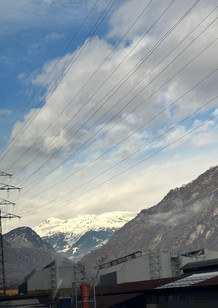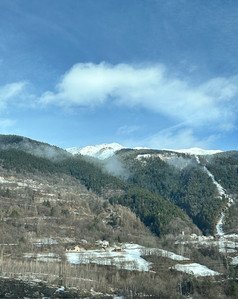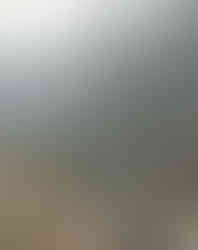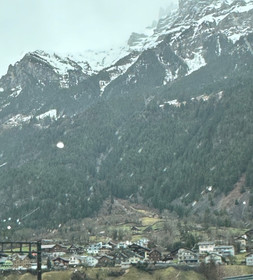Swiss Alps – Alpi Svizzere
- Maria Scuor
- Jan 21, 2024
- 6 min read
Scorri a basso per l'italiano
Driving to Switzerland to visit Gianni’s sister and family is always a beautiful scenic drive. Not far from the border, in the distances are the Swiss Alps in all their glory. I took so many photos (below) and put together this TikTok video to share with you the amazing beauty of this scenery.
I wanted to learn more about these incredible mountains and how they relate to the overall Alps. Here are the facts about the Alps:
They are the highest and most extensive mountain range within south-central Europe
Mountain range stretches 750 miles (1,200 km) and is crescent shape
Span across 8 countries: France, Switzerland, Monaco, Italy, Liechtenstein, Austria, Germany and Slovenia
Austria has the largest range at 28.7%. The rest are: Italy 27.2%, France 21.4%, Switzerland 13.2%, Germany 5.8%, Slovenia 3.6%, Liechtenstein 0.08% and Monaco at 0.01%
Mont Blanc, located on the France-Italy border is the highest mountain in the Alp and Western Europe at 15,766 ft (4,805 m)
The Matterhorn straddles Italy and Switzerland and is near-symmetric pyramidal peak
Largest cities within the Alps are: Grenoble/France, Innsbruck/Austria, Trento/Italy and Bolzano/Italy
There are many road tunnels through the Alps but the longest are: St. Gotthard/Switzerland (17 km), Arlberg/Austria (13.9 km), Frèjus/France/Italy (12.9 km), Mont Blanc/France/Italy (11.6 km)
Population of the region is 14 million spread across the eight countries
Alps provide lowland Europe with drinking water, irrigation and hydroelectric power. Cities such as Milan depend on 80% of their water source from the Alps runoff
Major European rivers flow from the Alps such as: Rhine, Rhone, Inn and Po. Other rivers such as the Danube have major tributaries flowing into them that originate from the Alps
There are 30,000 species of wildlife in the Alps, ranging from the tiniest snow fleas to largest brown bears
Alpine culture hasn’t changed since the medieval times when skills guaranteed survival in the mountains and strong traditions of carpentry, woodcarving, baking, pastry-making and cheesemaking are their mainstays
Cheesemaking is an ancient tradition in most Alpine countries where a wheel of Beaufort cheese can weigh 150 lb (70 kg)
Homes are built according to medieval designs in the high villages to withstand the cold winters. Roofs are constructed of Alpine rocks and the roof inclination doesn’t exceed 40%, allowing the snow to remain on the roof and functions as insulation
The Alps are a popular tourist destination with many resorts hosting over 120 million visitors per year
It is an experience driving through the many tunnels. From home in Arona to Bülach Switzerland we went through 71 different sized tunnels. The tunnels in Italy are definitely not as nice as the ones in Switzerland. Our drive takes us through the St. Gotthard Tunnel which is the longest 16.9 km (10.5 mi). When it was built in 1980 it was the longest tunnel in the world; it currently is fifth-longest.
It is a motorway tunnel which is on the A2 motorway (freeway) and consist of one bidirectional tube with two lanes. The maximum speed is 80 km/h (50 mph) and the journey across takes about 13 minutes by car. There are two railway tunnels that run under the Gotthard Massif Mountain Range, the Gotthard Tunnel built in 1882 and is 15 km (9.3 mi) long, and the Gotthard Base Tunnel built in 2016 which is 57.09 km (35.5 mi) long, making it the worlds longest and deepest railway tunnel.
In Oct 2001, a collision of two trucks created a fire in the tunnel, killing eleven people and injuring many more. The smoke and gases from the fires were the main cause of death. The tunnel was closed for two months for repairs and since then, no more than 150 trucks are allowed to enter the tunnel. A second road tunnel has been approved and work should commence in 2025 with a full completion date of 2032.
On the drive to Switzerland we stopped at a rest stop for a coffee and a bio break. Coffee and a brioche is definitely a lot more expensive than Italy. But this toilet is truly the best thing I've ever seen at a pit stop. Here is my TikTok video.
Going to Switzerland most of the Alps we saw had snow high above, however it snowed overnight and when we returned home there was a lot more snow. Here are some photos of the Swiss Alps and the little mountains with villages we saw on our drive.
Direction towards Switzerland - Direzione verso la Svizzera
Direction towards Italy - Direzione verso l'Italia
Alpi svizzere
Guidare in Svizzera per visitare la sorella e la famiglia di Gianni è sempre una bella strada panoramica. Non lontano dal confine, in lontananza si scorgono le Alpi svizzere in tutto il loro splendore. Ho scattato così tante foto (sopra) e ho messo insieme questo video TikTok per condividere con te la straordinaria bellezza di questo scenario.
Volevo saperne di più su queste incredibili montagne e su come si relazionano con le Alpi in generale. Ecco i fatti sulle Alpi:
Sono la catena montuosa più alta ed estesa dell'Europa centro-meridionale
La catena montuosa si estende per 1200 km ed è a forma di mezzaluna
Abbraccia 8 paesi: Francia, Svizzera, Monaco, Italia, Liechtenstein, Austria, Germania e Slovenia
L'Austria ha la catena montuosa più ampia, pari al 28,7%. Gli altri sono: Italia 27,2%, Francia 21,4%, Svizzera 13,2%, Germania 5,8%, Slovenia 3,6%, Liechtenstein 0,08% e Monaco 0,01%
Il Monte Bianco, situato al confine tra Francia e Italia, è la montagna più alta delle Alpi e dell'Europa occidentale con i suoi 4805 m
Il Cervino si trova tra l'Italia e la Svizzera ed è un picco piramidale quasi simmetrico
Le città più grandi delle Alpi sono: Grenoble/Francia, Innsbruck/Austria, Trento/Italia e Bolzano/Italia
Ci sono molte gallerie stradali che attraversano le Alpi, ma le più lunghe sono: San Gottardo/Svizzera (17 km), Arlberg/Austria (13,9 km), Frèjus/Francia/Italia (12,9 km), Monte Bianco/Francia/Italia (11,6 km)
La popolazione della regione è di 14 milioni di abitanti distribuiti negli otto paesi
Le Alpi forniscono all'Europa di pianura acqua potabile, irrigazione ed energia idroelettrica. Città come Milano dipendono per l'80% dalla fonte d'acqua proveniente dal deflusso delle Alpi
Dalle Alpi sgorgano i principali fiumi europei come: il Reno, il Rodano, l'Inn e il Po. Altri fiumi come il Danubio hanno grandi affluenti che sfociano in essi e che hanno origine dalle Alpi
Nelle Alpi ci sono 30000 specie di fauna selvatica, dalle più piccole pulci delle nevi ai più grandi orsi bruni
La cultura alpina non è cambiata dai tempi del Medioevo, quando le abilità garantivano la sopravvivenza in montagna e le forti tradizioni di falegnameria, intaglio del legno, panificazione, pasticceria e produzione del formaggio erano i loro pilastri
La produzione del formaggio è un'antica tradizione nella maggior parte dei paesi alpini, dove una forma di formaggio Beaufort può pesare 70 chilogrammi
Le case sono costruite secondo i disegni medievali nei villaggi alti per resistere ai freddi inverni. I tetti sono costruiti con rocce alpine e l'inclinazione del tetto non supera il 40%, consentendo alla neve di rimanere sul tetto e funziona come isolante
Le Alpi sono un popolare destinazione turistica con molte località che ospitano oltre 120 milioni di visitatori all'anno
È un'esperienza guidare attraverso i numerosi gallerie. Da casa ad Arona a Bülach, in Svizzera, abbiamo attraversato 71 gallerie di diverse dimensioni. Le gallerie in Italia non sono sicuramente belle come quelle in Svizzera. Il nostro viaggio ci porta attraverso il passo del San Gottardo, che è il più lungo 16,9 km. Quando fu costruito nel 1980 era il tunnel più lungo del mondo; Attualmente è il quinto più lungo.
Si tratta di un tunnel autostradale che si trova sull'autostrada A2 ed è costituito da un tubo bidirezionale a due corsie. La velocità massima è di 80 km/h e il viaggio dura circa 13 minuti in auto. Ci sono due tunnel ferroviari che corrono sotto la catena montuosa del massiccio del San Gottardo, il tunnel del San Gottardo costruito nel 1882 ed è lungo 15 km e il tunnel di base del San Gottardo costruito nel 2016 che è lungo 57,09 km, rendendolo il tunnel ferroviario più lungo e profondo del mondo.
Nell'ottobre 2001, una collisione di due camion ha creato un incendio nel tunnel, uccidendo undici persone e ferendone molte altre. Il fumo e i gas degli incendi sono stati la principale causa di morte. Il tunnel è stato chiuso per due mesi per riparazioni e da allora non più di 150 camion sono autorizzati a entrare nel tunnel. Una seconda galleria stradale è stata approvata e i lavori dovrebbero iniziare nel 2025 con una data di completamento completa nel 2032.
Durante il viaggio verso la Svizzera ci siamo fermati in un rest stop per un caffè e una pausa bio. Un caffè e una brioche sono sicuramente molto più costosi che in Italia. Ma questa toilette è davvero la cosa migliore che abbia mai visto durante un pit-stop. Ecco e il TikTok video
Andando in Svizzera la maggior parte delle Alpi che abbiamo visto aveva la neve in alto, tuttavia ha nevicato durante la notte e quando siamo tornati a casa c'era molta più neve. Sopra sone alcune foto delle Alpi svizzere e delle piccole montagne con i villaggi che abbiamo visto durante il nostro viaggio.





































































































Comments